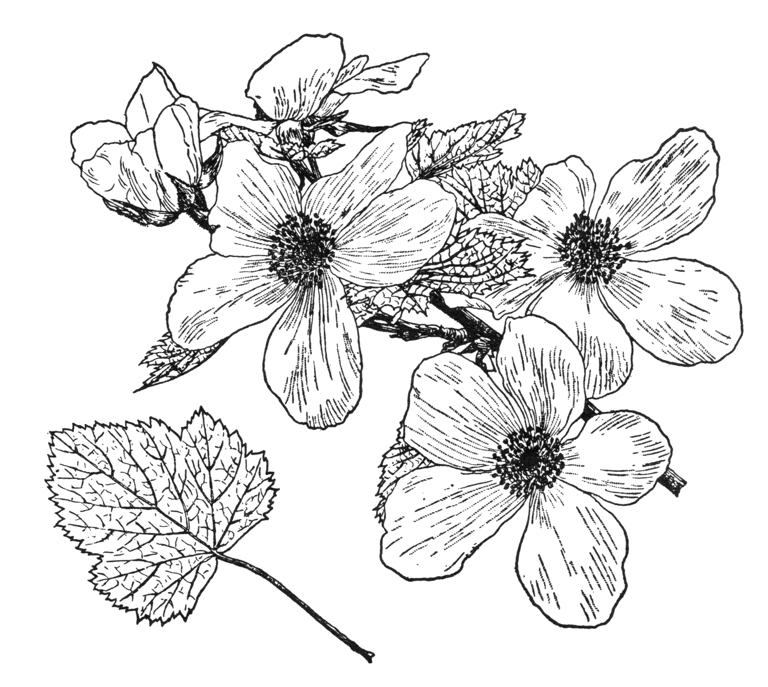A deciduous shrub of sturdy habit, reaching 6 to 10 ft in height, bark peeling; branches often arching or pendulous, quite unarmed, downy when young. Leaves like those of a blackcurrant in shape and size, being three- or five-lobed, with jagged edges, the base truncate or heart-shaped, 11⁄2 to 3 in. long, rather more wide, downy on both sides when young, especially beneath; stalk 1 to 11⁄2 in. long. Flowers mostly solitary, pure white, 2 in. across, borne in May on short twigs from the previous year’s branches; sepals downy, ovate, 1⁄2 in. long. Fruits 1⁄2 in. across, dry, and of no flavour. Bot. Mag., t. 6062.
Native of the Rocky Mountains of Colorado, New Mexico and Arizona; discovered in 1820 by Dr James. The fruit is not delicious but no doubt the name refers to the delight the flowers gave to the eye, for in this respect it is the most lovely of all Rubi, the blossoms being as beautiful as single roses, and as profusely borne. It was introduced in 1870. It is not very easily increased by cuttings (especially the better of two forms in cultivation), but can be layered, although the layers will sometimes take a twelvemonth before they become sufficiently rooted to be removable. A good loamy soil, a sunny position, and an occasional pruning out of the old wood complete its requirements. It is one of the elite of hardy shrubs.
R. trilobus Ser. R. mexicanus O. Kuntze – Closely allied to R. deliciosus and described earlier. Focke, the authority on Rubus, remarked that he could see no difference between the two species, except that the terminal lobe in R. trilobus is longer and the internodes longer, so that the branchlets are more widely spaced. Native of S. Mexico. It was in cultivation in the middle of the last century, probably from seeds collected by Hartweg, but the present stock was introduced by E. K. Balls and Dr W. Balfour Gourlay from the Pico de Orizaba, Veracruz, at 9-10,000 ft in 1938 (Bot. Mag., n.s., t. 452). The differences from R. deliciosus given in the article cited are that the leaves are larger, darker green, more finely toothed, with more acute lobes; and in having the sepals red on the inside in the fruiting stage. R. trilobus attains about 12 ft in gardens and a plant from the 1938 introduction received an Award of Merit when exhibited by Collingwood Ingram on May 20, 1947, from his garden at Benenden, Kent.
R. trilobus × R. deliciosus (‘Tridel’) ‘Benenden’. – From this cross, made about 1950 with R. deliciosus as the pollen parent, Collingwood Ingram raised three seedlings, of which the best was given the clonal name ‘Benenden’. This had flowered by 1954 and was described by the raiser in that year (Journ. R.H.S., Vol. 79 (1954), p. 540). It received an Award of Merit in 1958, and Award of Garden Merit in 1962 and a First Class Certificate in 1963. It is a vigorous shrub, producing annual stems 8 ft or more high, arching over in the following year and bearing in May or early June pure white flowers 21⁄4 to almost 3 in. wide. The foliage is variable in shape, but mostly takes after that of the pollen parent.


